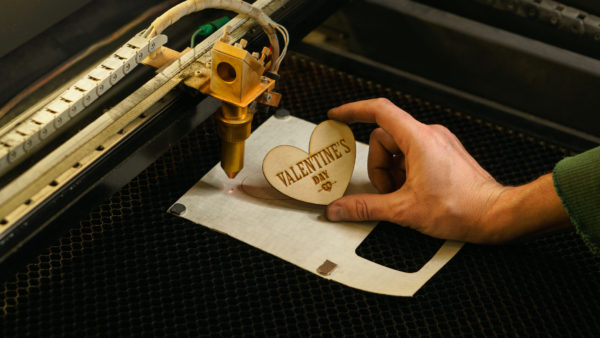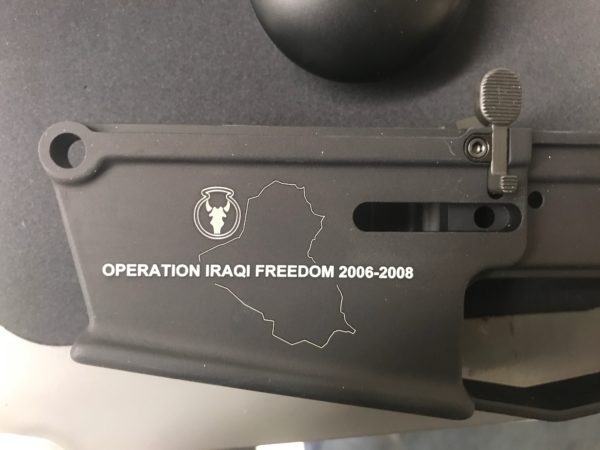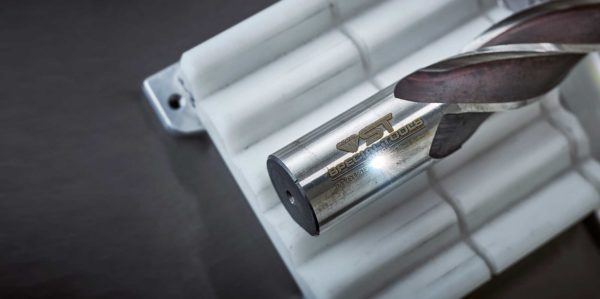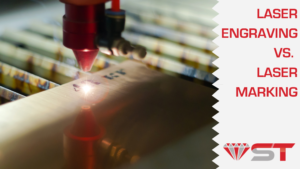There are many people out there that assume—for whatever reason—that laser engraving and laser marking are one and the same. Or, at the very least, similar enough to use interchangeably. Unfortunately, as anyone in the industry can tell you, this is not the case.
That isn’t to say the two methods of part customization have nothing in common. They both use lasers and operate under the same basic principles. Their scope of industries, applications, and materials overlap in many places as well.
With that said, some projects are ideal for laser marking while others are better suited for laser engraving. So, what are the differences between these two processes? Continue reading and we’ll explore the processes, methods, and advantages of each one in greater detail.
WHAT IS LASER ENGRAVING?
Laser engraving is a manufacturing process in which a focused beam of light is used to create a custom design—either text or image—by physically removing material from the surface of the piece. It is the most common option for those who want to personalize an item.

The Laser Engraving Process:
- The laser creates intense, focused heat, causing the material to vaporize with each pulse.
- This creates a shallow cavity in the surface that is both visibly and physically noticeable.
- For deeper engravings, the operator can perform several passes of the laser.
Methods of Laser Engraving:
- Laser Etching: Produces the shallowest depth of cut (0.001” or less) by slowly melting the surface, making it great for small projects and thin materials.
- Laser Ablation: Creates marks by removing surface coatings to expose the underlying layer, making it ideal for painted or anodized materials.
- Laser Engraving: Produces the deepest cuts (up to 0.02” in metals) through surface vaporization, making it the best choice for parts that experience high wear and tear.
Advantages of Laser Engraving:
- Greater durability
- Faster marking speed
- A broader range of depths
- Resistant to falsification
Ideal Laser Engraving Materials:
- Metals
- Plastics
- Wood
- Glass
- Acrylics
- Ceramics
Common Laser Engraving Applications:
- Part numbers
- Serial numbers
- Company logos
- Custom images
WHAT IS LASER MARKING?
Laser marking is a manufacturing process in which a low-heat laser burns a permanent, high-contrast impression into the surface of a workpiece. Unlike engraving, it does not remove any of the material, leaving the surface perfectly smooth and easy to read.

The Laser Marking Process:
- The laser creates a low-powered beam that slowly and precisely heats the material.
- This causes internal oxidation, which discolors the material while keeping the surface intact.
- The machine then applies low temperatures to the material to anneal the surface.
Methods of Laser Marking:
- Laser Annealing: This oxidation process is much slower as it applies heat without a high amount of aggression. Commonly used on carbon-containing metals in the medical industry.
- Laser Coloring: Utilizes a range of frequencies, speeds, and power levels to create a variety of colors on plastics and metals. Great for decorative jewelry and other personal items.
- Laser Foaming: This process uses a laser to melt the material, creating foamy gas bubbles that are often light in color. It is only used on plastics, particularly those of a darker shade.
- Carbon Migration: This process causes the material to chemically bond with its carbon molecules, creating a dark laser marking. Can only be used on metals and alloys that contain carbon, such as steel, stainless steel, carbide, and titanium.
Advantages of Laser Marking:
- Higher accuracy
- More customizability
- Less material waste
- Greater readability
Ideal Laser Marking Materials:
- Metals
- Metal alloys
- Plastics
Common Laser Engraving Applications:
- Barcodes
- QR codes
- Date codes
- Part numbers
- Serial numbers
- Custom text/images
- Copyright/trademark symbols

CHOOSE SPECIAL TOOLS FOR FULLY CUSTOMIZED LASER MARKING
Special Tools provides custom laser marking of any metal or carbide parts and tools. Using our Cobalt XL Laser from Laser Marking Technologies we are able to provide customers with fast turnaround and custom marks including images, logos, barcodes, and text.
Utilizing a high-speed, non-contact laser beam, we are able to provide a mark that is both consistent and detailed from part to part. Contact us today for a laser marking estimate.


